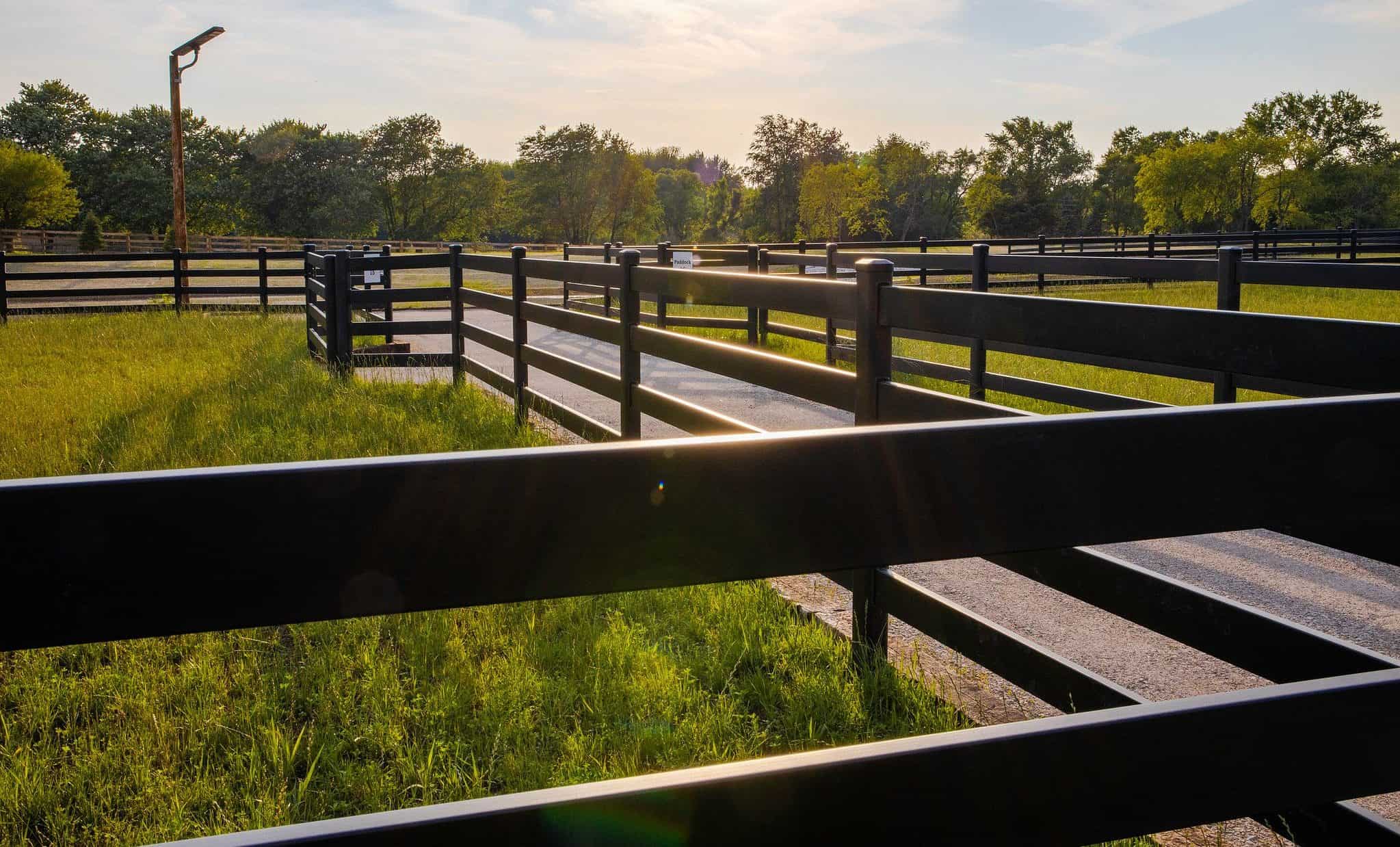Choosing the right fence material matters more than ever. With material costs rising and good help harder to find, the decision you make today will impact your property (and your time) for decades to come. We’ve seen too many property owners rush into decisions based on initial cost alone, only to find themselves replacing rotting boards or tightening loose wires just a few years later.
That’s why we created this guide. We’ve seen every type of fence imaginable across thousands of properties, from small horse paddocks to sprawling cattle operations. We’ve seen what holds up and what fails. We’ve watched materials evolve, and we’ve listened to property owners share their real-world experiences.
Whether you’re fencing in a few prize horses or an entire arena, this guide will help you make a choice you won’t regret.
Why Your Fencing Choice Matters More Than Ever
Today’s property owners face challenges our fathers never did. Material prices swing wildly from season to season. Labor costs have doubled, then doubled again. And mother nature? She’s throwing everything she’s got at us, from longer droughts to harsher winters. Your fence needs to stand up to it all.
Unfortunately, good folks make costly mistakes because they’re trying to save a dollar today. I’ve walked too many properties where owners are spending their weekends replacing broken boards or dealing with injured animals because they chose the wrong material. The true cost of fencing isn’t what you pay on day one. It’s what you pay—in both money and time—over the next twenty years.
When you’re choosing the best fence material, you’re not just picking a way to keep your animals in. You’re making decisions about:
- How many weekends you’ll spend on maintenance instead of with your family
- Whether your property value goes up or stagnates
- How safe your livestock will be during the next big storm
- What kind of legacy you’re leaving for the next generation
It’s why more ranchers and property owners are thinking beyond the initial price tag. They’re asking better questions about longevity, maintenance, and real value. And that’s exactly what we’re going to break down for you, material by material.
7 Best Fence Materials Ranked
| Material | Initial Cost | Lifespan | Maintenance Level | Safety Rating | Weather Resistance | Installation Complexity | Property Value Impact |
| Steel Board | High | 30+ years | Very Low | Excellent | Excellent | Low | Significantly Increases |
| Pipe Fence | Moderate-High | 25+ years | Low-Moderate | Good | Good | Moderate | Neutral |
| Wood Board | Moderate | 10-15 years | High | Fair | Poor | Low-Moderate | Decreases Over Time |
| Vinyl | Moderate-High | 15-20 years | Moderate | Fair | Fair | Low | Neutral |
| High-Tensile Wire | Low | 20+ years | Moderate-High | Poor-Fair | Good | Moderate | Slight Decrease |
| Electric | Low | 5-10 years | High | Fair | Poor | Low | Slight Decrease |
| Cable | Moderate | 15-20 years | Moderate-High | Poor | Good | High | Neutral |
1. Steel Board Fence
Steel board fencing isn’t just another option—it’s what happens when old-school ranch wisdom meets modern engineering. We started installing these systems about fifteen years ago, and I’ve watched them transform properties across the country.
Steel board fencing takes everything that made traditional wood fencing great and eliminates every weakness that used to keep ranchers up at night. The strength of steel, shaped into boards that give you that classic ranch aesthetic we all grew up with. But unlike those old wooden fences that seemed to need attention every time the wind blew, these steel boards stand their ground.
First, there’s the safety factor. The boards are smooth and secure, designed specifically to keep curious horses from testing their luck. No splinters, no sharp edges, no weak points that could give way under pressure. We’ve seen horses run full-speed into these fences during storms, and the horses walked away fine, and the fence didn’t even flinch.
Then, there’s durability. Snow, rain, brutal sun—none of it phases steel board fencing. While your neighbors are out painting and replacing rotted boards, you’ll be spending that time where it matters: with your animals or your family.
And once it’s properly installed, you’re looking at decades of service with minimal upkeep. No painting. No replacing warped boards. No tightening loose components every spring. It’s as close to “set it and forget it” as fencing gets in this business.
Yes, steel board fencing requires a larger upfront investment than some alternatives. But when you factor in maintenance, replacement costs, and your time over 20 years, steel board fencing often proves to be the most economical choice. Not to mention what it does for property values—we’ve seen real estate agents specifically highlight steel board fencing in their listings because buyers recognize the value.
2. Pipe Fence
Pipe fencing has been a ranch country staple for generations, and for good reason. Sturdy, functional, and when properly installed, it can handle just about anything your cattle throw at it.
The strength is there, no question. Good steel pipe can take a beating from your heaviest livestock and keep on standing. Maintenance is relatively straightforward too—a bit of paint every few years, and you’re usually good to go.
However, while pipe fencing excels in durability, it falls short in other areas that modern property owners care about. The aesthetic is purely industrial. It can hugely impact your property’s resale value, especially if you’re in an area where appearances matter. Installation costs have skyrocketed with metal prices, and you’re still looking at regular painting to prevent rust.
For cattle operations focused purely on function, pipe fencing remains a viable option. But for those seeking a balance of strength, aesthetics, and long-term value, this is where steel board fencing offers clear advantages.
3. Wood Board Fence
There’s something about those clean lines of fresh lumber stretching across a property that just feels right. It’s what most of us grew up with, and for generations, it was the gold standard in horse country.
But nostalgia aside, let me be frank about what we’re seeing in the field today. Wood fencing is becoming a liability that most property owners simply can’t afford. The quality of lumber isn’t what it used to be, and prices have gone through the roof. What used to last 15 years now starts showing serious wear in half that time.
You’re looking at repainting every 2-3 years, replacing broken or rotted boards regularly, and constant monitoring for protruding nails or splintered edges that could harm your animals. After major storms, you’ll often find yourself out there replacing entire sections. Time and weather are simply unforgiving to wood—no matter how well you maintain it.
Unfortunately, most folks only realize what they’ve signed up for after they’re a few years in and watching their investment literally rot away. For the same money—often less in the long run—you could have installed steel board fencing and been done with it.
4. Vinyl Fence
I see the appeal of vinyl fencing, I really do. It’s got that clean, white appearance that looks sharp when it’s first installed, and the manufacturers make some mighty fine promises about maintenance-free living. But let me tell you what we’ve learned the hard way.
That pristine white fence turns into a constant battle with dirt and algae in most climates. More concerning is what happens in extreme temperatures. We’ve watched vinyl get brittle and crack in severe cold, then warp and sag under the summer sun. And if one section gets damaged? You’re often looking at replacing entire panels rather than just a single board.
The breaking strength just isn’t there either. I’ve seen horses go right through vinyl fencing during storms or when spooked. That’s not a phone call any property owner wants to get at midnight. While vinyl might work fine for decorative purposes around a house, it’s simply not up to the demands of serious livestock containment.
5. High-Tensile Wire
High-tensile wire has gotten a lot of attention lately, particularly from folks looking to fence large acreage on a budget. The sales pitch is tempting: low material costs, quick installation, minimal maintenance. And for some operations, especially those running cattle on extensive grazing land, it has its place.
But here’s what the catalogs won’t tell you. Wire fencing—even the high-tensile variety—demands regular attention to maintain proper tension. One loose section compromises your entire fence line. Wildlife pressure, falling branches, even temperature changes can affect wire tension. You’ll spend more time than you’d like walking the fence line with tools in hand.
The safety concerns are real too. While cattle generally respect wire fencing, horses are a different story. We’ve dealt with too many cases of horses getting tangled in wire fencing, sometimes with devastating results. And visibility? In low light or bad weather, wire fencing becomes nearly invisible to both animals and humans.
6. Electric Fence
Electric fencing has its place in temporary setups and rotational grazing systems. It’s relatively cheap to install, and when properly maintained, it can be effective at controlling livestock movement. Some of our customers use it as a helpful addition to their permanent fencing systems.
Still, you’re dealing with a system that needs constant monitoring. Power outages, shorts from wet vegetation, and battery failures can all compromise your fence without warning. Plus, there’s the ongoing cost of electricity or battery replacements to consider.
The biggest issue? It’s purely psychological control, not physical containment. One failed charger, one missed payment on your electric bill, or one lightning strike, and you’ve got no fence at all.
7. Cable Fence
Cable fencing shows up in catalogs looking sleek and modern, and it can work for some specific applications like perimeter fencing on non-livestock properties. The minimalist appearance appeals to folks wanting unobstructed views of their land.
In livestock applications, cable fencing is asking for trouble. The tension required to keep cables tight can create a dangerous situation if an animal runs into it. We’ve seen cables act like cheese slicers when hit with enough force. They’re also notorious for sagging over time, requiring regular re-tensioning to maintain effectiveness.
The maintenance isn’t just about tension either. Cables can fray, creating sharp ends that can injure both animals and handlers. Connection points often become weak spots, especially in areas with frequent temperature swings. And replacing a damaged section? It’s not the simple fix you might expect.
Choose Buckley Fence for Better Fencing
At Buckley Fence, we’re not just selling you fencing material—we’re providing you with peace of mind. Our steel board fencing systems are engineered to outlast and outperform every other option on the market. We’ve refined our designs based on real feedback from ranchers, horse owners, and property managers who demand the best.
While other fencing options might save you money upfront, our steel board fencing proves its value year after year. No endless maintenance cycles. No replacement costs. No midnight emergencies with escaped livestock. Just solid, dependable performance that lets you focus on what matters: your animals, your land, and your legacy.
We’ve helped property owners make the switch to better horse fencing, and we’re ready to do the same for you. Our team of fencing experts will work with you to design a solution that fits your specific needs and budget. We’ll show you exactly why steel board fencing isn’t just another option—it’s the future of farm and ranch fencing.
Ready to invest in fencing that will serve you for decades to come? Let’s talk about how we can help you protect what matters most.



